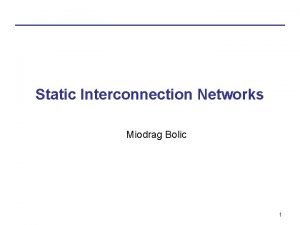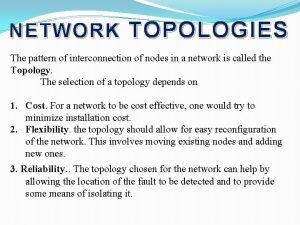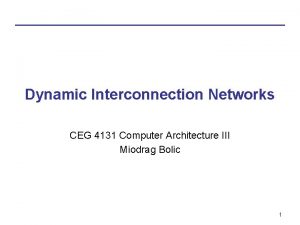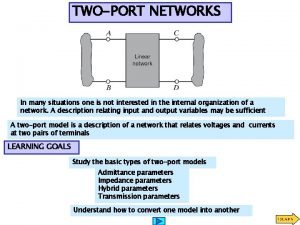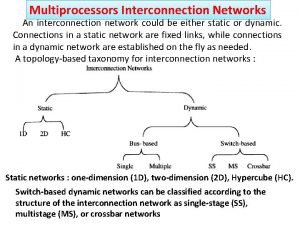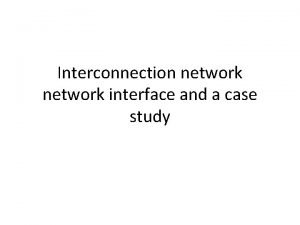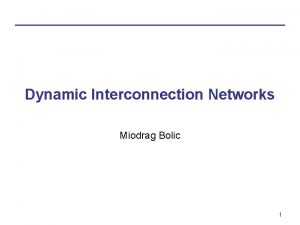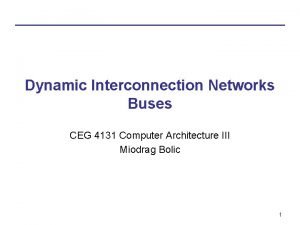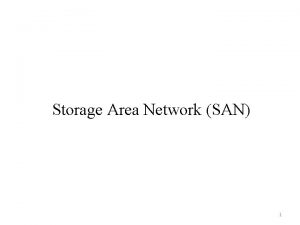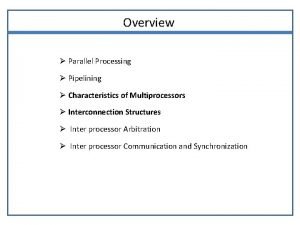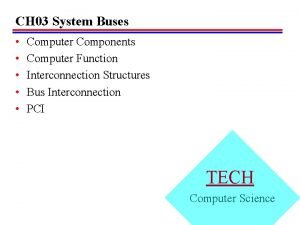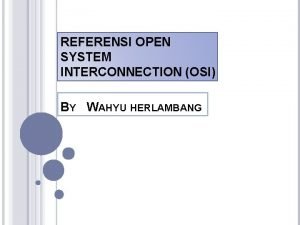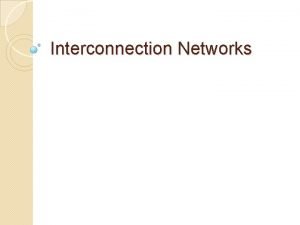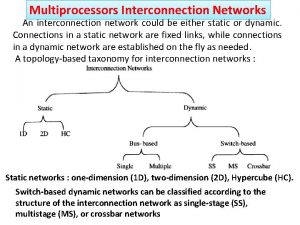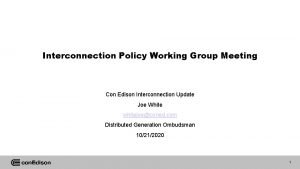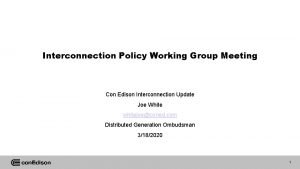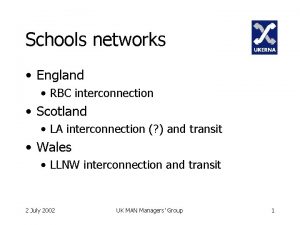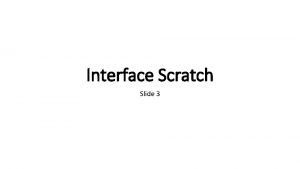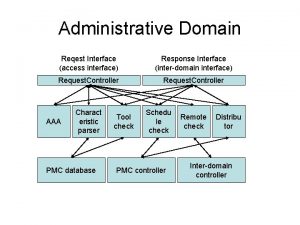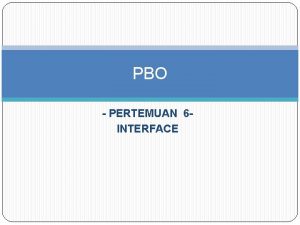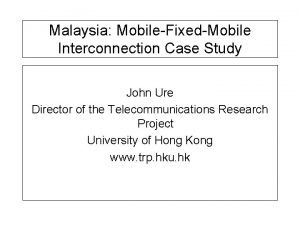Interconnection network interface and a case study Network


























- Slides: 26

Interconnection network interface and a case study

Network interface design issue • The networking requirement user’s perspective – In-order message delivery – Reliable delivery • Error control • Flow control – Deadlock free • Typical network hardware features – Arbitrary delivery order (adaptive/multipath routing) – Finite buffering – Limited fault handling • How and where should we bridge the gap? – Network hardware? Network systems? Or a hardware/systems/software approach?

The Internet approach – How does the Internet realize these functions? • No deadlock issue • Reliability/flow control/in-order delivery are done at the TCP layer? • The network layer (IP) provides best effort service. – IP is done in the software as well. – Drawbacks: • Too many layers of software • Users need to go through the OS to access the communication hardware (system calls can cause context switching).

Approach in HPC networks • Where should these functions be realized? – High performance networking • Most functionality below the network layer are done by the hardware (or almost hardware) – This provide the APIs for network transactions • If there is mis-match between what the network provides and what users want, a software messaging layer is created to bridge the gaps.

Messaging Layer • Bridge between the hardware functionality and the user communication requirement – Typical network hardware features • Arbitrary delivery order (adaptive/multipath routing) • Finite buffering • Limited fault handling – Typical user communication requirement • In-order delivery • End-to-end flow control • Reliable transmission

Messaging Layer

Communication cost • Communication cost = hardware cost + software cost (messaging layer cost) – Hardware message time: msize/bandwidth – Software time: • Buffer management • End-to-end flow control • Running protocols – Which one is dominating? • Depends on how much the software has to do.

Network software/hardware interaction -- a case study • A case study on the communication performance issues on CM 5 – V. Karamcheti and A. A. Chien, “Software Overhead in Messaging layers: Where does the time go? ” ACM ASPLOS-VI, 1994.

What do we see in the study? • The mis-match between the user requirement and network functionality can introduce significant software overheads (50%-70%). • Implication? – Should we focus on hardware or software/hardware co-design? – Improving routing performance may increase software cost • Adaptive routing introduces out of order packets – Providing low level network feature to applications is problematic.

Summary from the study • In the design of the communication system, holistic understanding must be achieved: – Focusing on network hardware may not be sufficient. Software overhead can be much larger than routing time. • It would be ideal for the network to directly provide high level services. – The newer generation interconnect hardware tries to achieve this.

Case study • IBM Bluegene/L system • Infini. Band

Interconnect Family share for 06/2011 top 500 supercomputers Interconnect Family Count Share % Rmax Sum (GF) Rpeak Sum (GF) Processor Sum Myrinet 4 0. 80 % 384451 524412 55152 Quadrics 1 0. 20 % 52840 63795 9968 Gigabit Ethernet 232 46. 40 % 11796979 22042181 2098562 Infiniband 206 41. 20 % 22980393 32759581 2411516 Mixed 1 0. 20 % 66567 82944 13824 NUMAlink 2 0. 40 % 107961 121241 18944 SP Switch 1 0. 20 % 75760 92781 12208 Proprietary 29 5. 80 % 9841862 13901082 1886982 Fat Tree 1 0. 20 % 122400 131072 1280 Custom 23 4. 60 % 13500813 15460859 1271488 Totals 500 100% 58930025. 59 85179949. 00 7779924

Overview of the IBM Blue Gene/L System Architecture • Design objectives • Hardware overview – System architecture – Node architecture – Interconnect architecture

Highlights • A 64 K-node highly integrated supercomputer based on system-on-a-chip technology – Two ASICs • Blue Gene/L compute (BLC), Blue Gene/L Link (BLL) • Distributed memory, massively parallel processing (MPP) architecture. • Use the message passing programming model (MPI). • 360 Tflops peak performance • Optimized for cost/performance

Design objectives • Objective 1: 360 -Tflops supercomputer – Earth Simulator (Japan, fastest supercomputer from 2002 to 2004): 35. 86 Tflops • Objective 2: power efficiency – Performance/rack = performance/watt * watt/rack • Watt/rack is a constant of around 20 k. W • Performance/watt determines performance/rack

• Power efficiency: – 360 Tflops => 20 megawatts with conventional processors – Need low-power processor design (2 -10 times better power efficiency)

Design objectives (continue) • Objective 3: extreme scalability – Optimized for cost/performance use low power, less powerful processors need a lot of processors • Up to 65536 processors. – Interconnect scalability – Reliability, availability, and serviceability – Application scalability

Blue Gene/L system components

Blue Gene/L Compute ASIC • 2 Power PC 440 cores with floating-point enhancements – 700 MHz – Everything of a typical superscalar processor • Pipelined microarchitecture with dual instruction fetch, decode, and out of order issue, out of order dispatch, out of order execution and out of order completion, etc – 1 W each through extensive power management

Blue Gene/L Compute ASIC

Memory system on a BGL node • BG/L only supports distributed memory paradigm. • No need for efficient support for cache coherence on each node. – Coherence enforced by software if needed. • Two cores operate in two modes: – Communication coprocessor mode • Need coherence, managed in system level libraries – Virtual node mode • Memory is physical partitioned (not shared).

Blue Gene/L networks • Five networks. – 100 Mbps Ethernet control network for diagnostics, debugging, and some other things. – 1000 Mbps Ethernet for I/O – Three high-band width, low-latency networks for data transmission and synchronization. • 3 -D torus network for point-to-point communication • Collective network for global operations • Barrier network • All network logic is integrated in the BG/L node ASIC – Memory mapped interfaces from user space

3 -D torus network • Support p 2 p communication • Link bandwidth 1. 4 Gb/s, 6 bidirectional link per node (1. 2 GB/s). • 64 x 32 torus: diameter 32+16+16=64 hops, worst case hardware latency 6. 4 us. • Cut-through routing • Adaptive routing

Collective network • Binary tree topology, static routing • Link bandwidth: 2. 8 Gb/s • Maximum hardware latency: 5 us • With arithmetic and logical hardware: can perform integer operation on the data – Efficient support for reduce, scan, global sum, and broadcast operations – Floating point operation can be done with 2 passes.

Barrier network • Hardware support for global synchronization. • 1. 5 us for barrier on 64 K nodes.

IBM Blue. Gene/L summary • Optimize cost/performance – limiting applications. – Use low power design • Lower frequency, system-on-a-chip • Great performance per watt metric • Scalability support – Hardware support for global communication and barrier – Low latency, high bandwidth support
 Static interconnection network
Static interconnection network Chordal ring
Chordal ring Bus topology
Bus topology Dynamic interconnection network in computer architecture
Dynamic interconnection network in computer architecture Two ports containing no sources then
Two ports containing no sources then Lara srivastava
Lara srivastava Lara srivastava
Lara srivastava Network interconnection studies
Network interconnection studies Dr bolic
Dr bolic Dynamic interconnection network
Dynamic interconnection network Best worst and average case
Best worst and average case Hershey's erp failure
Hershey's erp failure What is interface in java
What is interface in java Office interface vs industrial interface
Office interface vs industrial interface Office interface vs industrial interface
Office interface vs industrial interface An interface
An interface Network forensics case study
Network forensics case study Storage area network
Storage area network What is computer function
What is computer function Sequential interrupt processing
Sequential interrupt processing Time shared common bus
Time shared common bus Bus interconnection scheme diagram
Bus interconnection scheme diagram Model open system interconnection
Model open system interconnection Bris business registers interconnection system
Bris business registers interconnection system What is interprocessor arbitration
What is interprocessor arbitration Direct interconnection networks
Direct interconnection networks Computer components: top-level view
Computer components: top-level view
